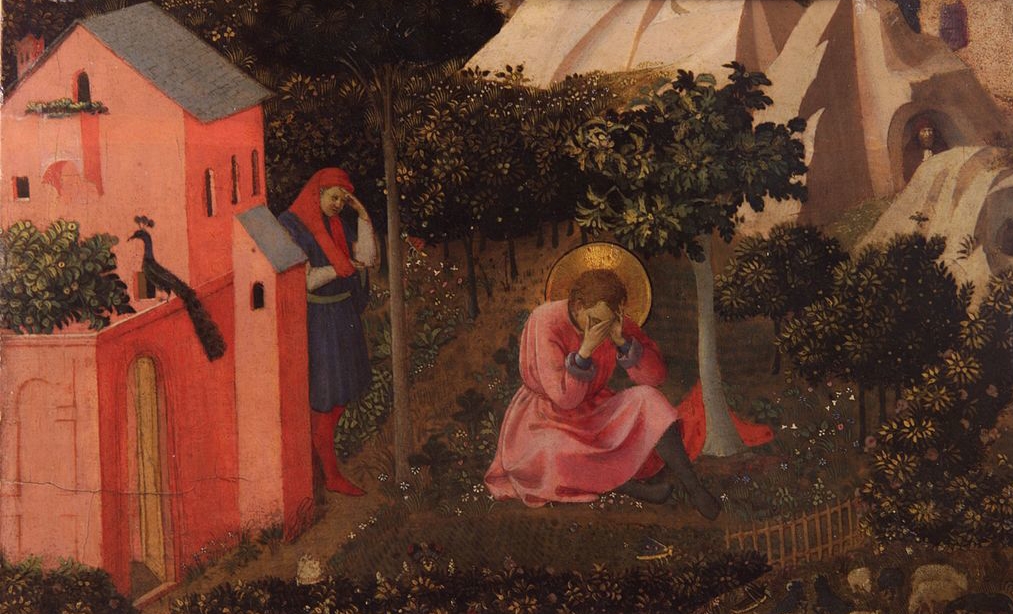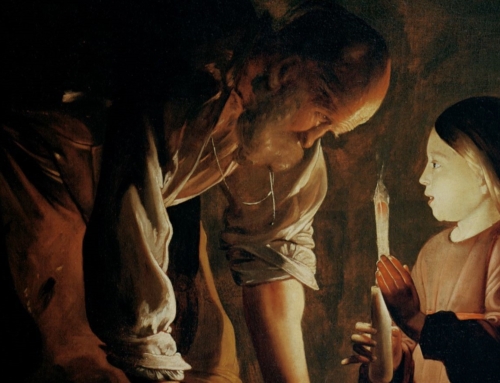Saints are not made in a vacuum; they’re made in Christ.
The saints belong to the Body of Christ, and within this Body, their lives intertwine, intersect, influence one another. Like a thread, the biography of one saint weaves into the biography of another saint. The threads stitch together forming a union. Ultimately, this union and close relation finds its perfection in heaven. If birds of a feather flock together, saints together praise God forever. As the spokes of a wheel approach the center, they become closer to each other. Similarly, when the saints draw close to God, they also come closer to each other and to us.
St. Augustine’s conversion, described in The Confessions, epitomizes the ties formed among believers who draw near the Eternal Father. Plucking the thread of his life vibrates the threads of St. Monica (his mother) and St. Ambrose (bishop of Milan), both living at the time. The reverberation extends beyond Augustine’s contemporary setting to the setting of heaven, where St. Athanasius, St. Anthony of the desert, and St. Paul all behold the face of God.
Leading up to Augustine’s conversion, St. Monica offered rivers of tears for her son’s conversion. St. Ambrose poured forth a torrent of words pushing the future saint toward conversion. Yet, it was the rain-drop words of an anonymous child that lifted Augustine from the mud of his tears. A simple, repeated chant—tolle lege (take up and read)—fell on Augustine’s ear while he laid face down in the throes of a spiritual struggle. Upon hearing this command, he was reminded of the hermit in the desert, St. Anthony. Augustine writes,
I checked the flow of tears and got up, for I interpreted this solely as a command given to me by God to open the book and read the first chapter I should come upon. For I had heard how Anthony had been admonished by a reading from the Gospel at which he chanced to be present, as if the words read were addressed to him: ‘Go, sell your possessions, and give the money to the poor, and you will have treasure in heaven; then come, follow me,’ (Mt 19:21) and that by such a portent he was immediately converted to you.
It’s likely that Augustine learned of Anthony’s life through Athanasius’ biography of him. One saint writing about another saint directly affected a third saint. Aware of Anthony’s conversion, Augustine opened Scripture with the intent of hearing God, and God spoke to Augustine through St. Paul:
Not in revelling and drunkenness, not in debauchery and licentiousness, not in quarrelling and jealousy. Instead, put on the Lord Jesus Christ, and make no provision for the flesh, to gratify its desires. (Rm 13:13–14)
Augustine records that a peaceful light streamed into his heart upon reading these words. Grace had entered his soul, he believed. Leading up to his conversion several saints entered into his life coaxing, inspiring, adjuring, and moving him to the Lord. Aquinas explains that God has established an order in which the last should be led to Him by those that are midway between, i.e., the saints. After his conversion, St. Augustine would be baptized, thereby enter the Church, and overflow in teaching and wisdom. His life incorporated into the Body of Christ adds another member to the communion of saints.
This is not just true of Augustine’s life. St. Gregory of Nazianzus’ story connects with the lives of St. Basil, his saintly mother and father, saintly brother and sister, and St. John Chrysostom. St. Thomas Aquinas’ path to the Summa crosses the paths of St. Albert the Great, St. Bonaventure, Bl. Humbert of Romans, and St. Agnes. Even the missions of contemporaries like St. John Paul II and St. Mother Teresa intertwine.
Holiness attracts holiness, and the holy spur the holy. God delights in raising up holy men and women in a manner that manifests the communion in heaven. There’s something fitting about an assembly of believers rising up in holiness so that they might spend eternity together singing the praises of God. What’s more, the saints already enjoying the vision of glory offer their help to us who are still on the way. They offer their communion to us so that we might achieve excellence, perfect charity. This communion is so powerful and tied up in God that even the prayers of an unknown hermit can weave their way from heaven into the fabric of our daily life.
✠
Image: Fra Angelico, Conversion of Saint Augustine







